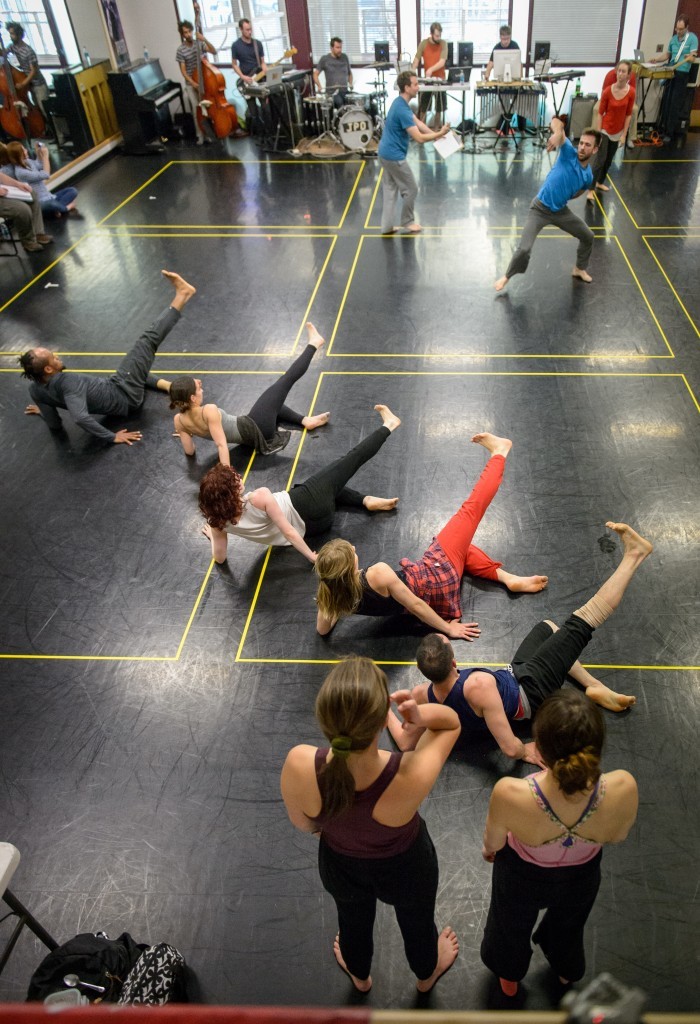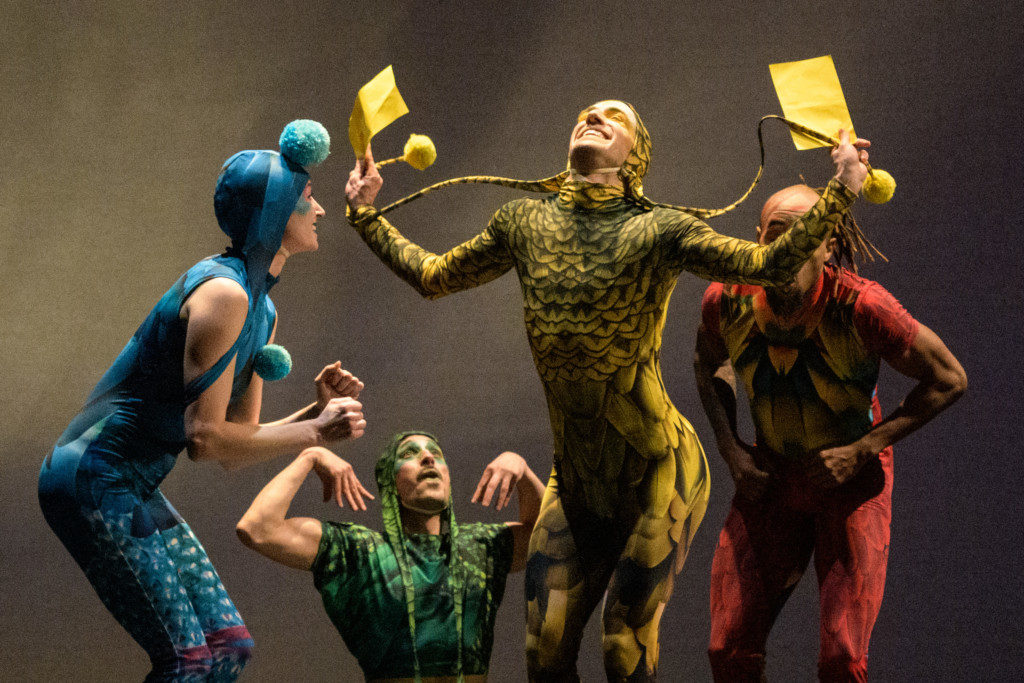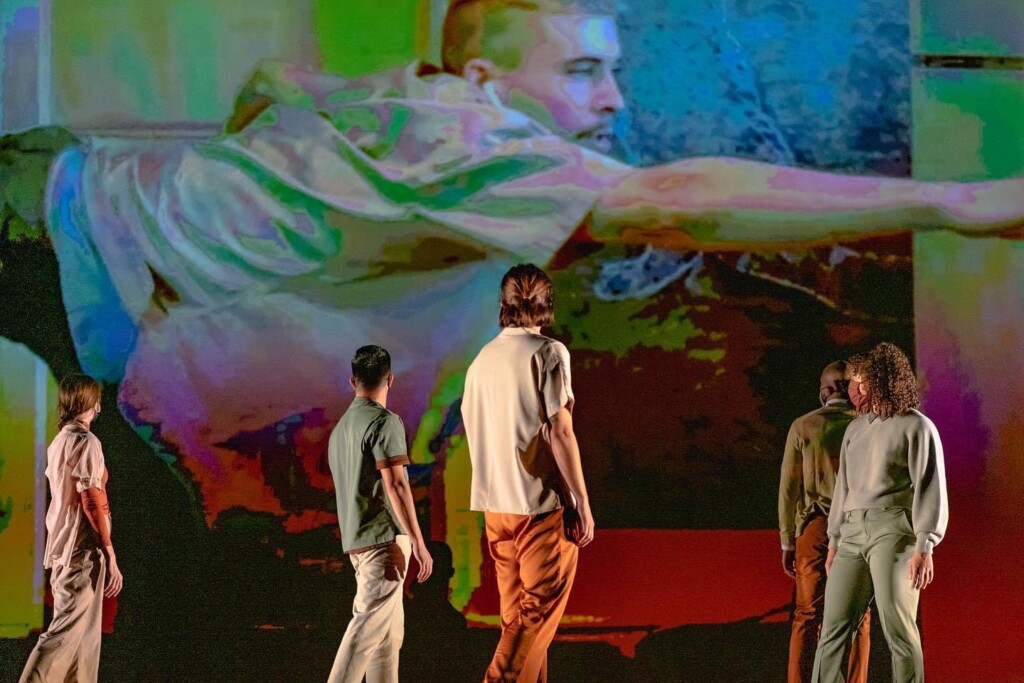Along with a world premiere by the locally based choreographer duo LajaMartin, Precipice, the 59th season opener for the Ririe-Woodbury Dance Company, will feature the reconstruction of To Have and to Hold, one of the most widely known dance compositions by Danial Shapiro and Joanie Smith also known as the “bench piece,” and the return of Everything That Changes, the first work Daniel Charon choreographed for the company in his first season as artistic director.
The concert, which marks Charon’s 10th anniversary with Ririe-Woodbury, will have its three-day run in the Jeanné Wagner Theatre in the Rose Wagner Center for Performing Arts: Sept. 22-24 at 7:30 p.m. as well as the Moving Parts Family and Sensory Friendly matinee on Sept. 24 at 1 p.m.
Laja Field and Martin Ďurov, the principals of LajaMartin, are known for a choreographic language that resonates with earthy authenticity and breathtaking physicality in movement. Their work, The Bunker, is filled with the duo’s trademark elements including drama, romance, comedy, props and their consistently thrilling movement language.
Shapiro and Smith’s To Have and To Hold was created in 1989 as a response to the AIDS crisis. In a 2015 interview with DanceTeacher magazine, Smith recalled how benches became part of the work: “We’d gone to Finland for a year—I’d gotten a Fulbright lectureship—and when we came back to the U.S. nine or 10 months later, it just seemed that everything had changed. So many people had died of AIDS, there were divorces. We started thinking how slippery relationships are—they just slide by. So that’s where we came up with the benches, and that’s why we slide on them. We wanted the most simple, the barest kind of seating.”
When Daniel Charon arrived in Salt Lake City as Ririe-Woodbury Dance Company’s artistic director, the internationally known dance institution was marking its golden anniversary. The past decade has certainly magnified Ririe-Woodbury’s distinguished reputation. During Charon’s tenure to date, the company has presented 18 original dance works by him, as well as pieces from 47 guest artists.
In an interview with The Utah Review, Charon says the restaging of Everything That Changes is nostalgic in some respects because it is a work of “youthful exuberance” and it is interesting to see “what I was interested at the time I created it and how I have changed in the last 10 years.”

It has been an exciting decade under Charon’s artistic leadership. Visiting choreographers have included some of dance’s most widely known rising stars: Netta Yerushalmy, Joanna Kotze, Raja Feather Kelly, Keerati Jinakunwiphat, Culture Mill (Clint Lutes, Murielle Elizéon and Tommy Noonani) and Yin Yue. Ririe-Woodbury also has generously opened its creative spaces to local artists, including LajaMartin, Ann Carlson, Molly Heller, Stephen Koester and Michael Wall, among others. Dancers from area universities including Utah Valley University (who will be performing at Precipice) and The University of Utah have joined the company’s dance artists in concerts. Charon collaborated with the Sale Lake Electric Ensemble to create two evening-length works, which included both live performances, recorded original music and the ensemble’s internationally acclaimed interpretation of Terry Riley’s minimalist masterpiece In C. One work, created for family audiences, brought in Dallas Graham of the Red Fred Project and the Flying Bobcat Theatrical Laboratory. Next spring, Charon will premiere an evening length work of dance theater, in collaboration with stage director Alexandra Harbold. During the pandemic, with live performances grounded for many months, the company produced filmed concerts, including one with Repertory Dance Theatre.
“It has been a satisfying joy to generate so much work during the last nine to ten years, especially with dancers who support each other, have exceptional character and work ethic,” Charon adds. In the last couple of years, the experiences of coping with the pandemic – which have included auditions via Zoom and filmed concerts streamed on demand – actually have strengthened the company’s resilience and ensemble chemistry. Charon says that among the most significant takeaways as he completes his first decade with Ririe-Woodbury is how he has inculcated the values of spontaneity and trust in his instincts as a choreographer. Certainly, Charon consistently acknowledges how much the creative process for setting a new piece involves genuine collaboration with the company’s dance artists.

In Charon’s second season, there was one of the boldest, most widely anticipated experiments of artistic collaboration in Salt Lake City up to that time. He set 53 Rooms, which incorporated 20 dancers on stage and a live performance of Terry Riley’s In C, a pioneering work of the minimalist music period, by the Salt Lake Electric Ensemble (SLEE). “For those of us who have been so heavily focused in music and uneducated or underexposed to dance, it has been fascinating to tap into the energy of how the dancers respond to Riley’s music,” Oliver Lewis, then a SLEE member, said at the time in an interview with The Utah Review.
Charon also premiered Shift, the first installment of a trilogy — Together Alone, which used dance to explore the sociocultural phenomenon of the virtual self in the age of social media. In sum, the trilogy examined the challenges of overcoming loneliness and false sensations of narcissism and connection in order to find a refreshingly sincere psychological community along with emotional support and intelligence. In the first installment, Charon’s choreography replicated with convincing effect the scientific and technological concepts he had in mind, such as duets representing the binary code strings of 0s and 1s as well as the double helix of DNA. “It then opens the door to locate our consciousness – are we still out there,” he explained in an earlier interview.

Photo Credit: Stuart Ruckman.
The trilogy also reflected, in part, Charon’s love of science fiction. For the second part, Enter, he worked with local composer Michael Wall, who has provided an encyclopedic catalog of music, samples, mixes and other sound design elements to choreographers and dancers. Charon described the second part as exploring the “multiplicity of ourselves – anonymous, real and imagined – through the avatars and profiles we use to define our existence in digital space and digital realities.” Enter, he added, then sets the context of how perhaps we can overcome the dread of depression or loss and use our solitude to contemplate and rediscover ways of making meaningful relationships in the digital age without necessarily disconnecting our digital selves.
Completing the trilogy, Return was a new realm of dance theater, which imagined the six dancers aboard a starship on a galactic journey, one of the classic elements of science fiction literature. Charon again turned to the Salt Lake Electric Ensemble, to produce an original soundtrack. In Return, the dancers speak text in several instances, including original dialogue by Robert Tennant, Google Artificial Intelligence and brief quotes from Kim Stanley Robinson’s science fiction novel Aurora (Orbit, 2015). Some of the dialogue is spoken in Spanish.
Return, which takes just a little more than an hour, absorbs the audience. At times, the dancers convey restlessness in their isolated environment, building the tension of wondering how they will ever liberate themselves from a space that is so restricted and their capacity for fully human interactions is even prohibited. The surprising thing about the spoken text up until the last short soliloquy is its mundane futility but then the final words uttered by one of the dancers clinch the redeeming effect. The passionate warmth of dance comes through – the opportunity to soothe the flattening pain of our digital and technological environment with the earnest appeal for loving interaction.
His love of literature has sparked unique choreographic compositions. Dance for a Liminal Space’s most intriguing element was its presentation. It was set in two sections but each with different music (contemporary composers Meredith Monk and Michael Gordon) and costumes (designed by dance artist and former company member Melissa Younker). The first segment was presented before intermission and the second following the break. Indeed, the break enhanced how the audience reflects upon the first segment and connects it to the second section. “The first part is introspective and isolating, as it comes from a dark space in one’s consciousness,” Charon says, “while the second signifies that time has passed and expresses how one filters through their memories and perhaps even return to something they had forgotten about.”
In 2020, just before the pandemic, Aberrations of Light premiered. Charon built the piece from a line in the 1994 book Pale Blue Dot: A Vision of the Human Future in Space by Carl Sagan: “No longer confined to a single world, we are now able to reach out to others and determine decisively what kind of planetary system we inhabit.”
Charon has periodically set work responding to contemporary events. One was Elegy, created in memory of the victims killed during the 2016 mass shooting at the Pulse nightclub in Orlando. Suggesting a ghost-like memory, the work was choreographed to music by Bach. Next spring, the company will close its season with an evening length work To See Beyond Our Time, a work Charon is setting in collaboration with Harbold. The impetus for the work is to augment efforts to save and preserve the Great Salt Lake.
In more recent years, some of his work has exhibited a distinctive exuberance, which the company’s dance artists have conveyed with marvelous and delightful results. One was Exilic Dances, which he said was “a work about family and community, and embracing and welcoming a stranger.” Once again displaying his astute grasp on pop culture he added, “It’s like musical theater: Fiddler on The Roof meets Chicago meets South Park.”
Indeed, Exilic Dances, a suite of eight pieces with music by Klezmer Juice and Golem, was an exhilarating tour de force of dance musical theater. Charon’s choreography transformed a “vessel of songs” (klezmer) into a mini-musical where the multi-generational story is told exclusively through dance. An inner core of slow-tempo songs was surrounded by fast-paced numbers, beginning with a Prologue titled Ose Shalom, which translates as the One Who Makes Peace.
At a time when talks of immigration and its historical value often descend into noxious tones, Exilic Dances emerged as a refreshing tonic, a celebration of ancestral roots, cultural pride and newfound respect for a country that translates effectively to any immigrant tradition. Klezmer music’s essentially global character propelled the boisterous and humorous feel of Charon’s choreography, executed with infectious charm by the company’s dancers who also did not miss a beat working with and clearing the numerous props incorporated into the performance.
Last year, to open the company’s 58th season and the return to live performances for the first time in 20 months, Charon set On Being, a work of pure natural energy that introduced audiences to the company’s six dance artists, including five of whom either were then in their first or in their second season. The work elicited distinctive personality traits of the artists and the dancers visibly were delighted as they did artistic justice to an elegantly choreographed statement on the theme of solace. There were moments of remembrance but also joy in the return to unrestrained movement, where partnering once again seemed natural. On Being offered a well-earned respite from the emotionally taxing prolonged period that all of us endured since the early spring of 2020. Meanwhile, to close the same season, Charon set The Break of Day, a starburst of choreographic joy with a rhythmic language that popped perfectly with the music of The Chairman Dances: Foxtrot for Orchestra by composer John Adams, a musician who has been a particular favorite of numerous choreographers.
Prior to the 55th season, the company traveled abroad as cultural ambassadors, part of DanceMotion USA℠’s cultural diplomacy program, which was coordinated with the U.S. Department of State’s Bureau of Educational and Cultural Affairs and administered by The Brooklyn Academy of Music (BAM). Ririe-Woodbury was one of three American dance companies selected for the program.
In a previous interview with The Utah Review, Charon said, of the impact of the trip, that the cultural mission in Asia confirmed that “we really don’t need to change the wheel.” But, he added that it also enlivened and strengthened everyone’s sensibilities and sensitivities about making the connection to different audiences and demonstrating how dance for everyone can be anything and everything but intimidating and discriminating based on ability or experience. This became the seed for the company’s Moving Parts Family and Sensory Friendly matinee series.
Charon previously danced in choreographer Doug Varone’s company for 10 years. Varone’s relationship to Ririe-Woodbury has spanned nearly 30 years, starting with Smashed Landscapes, a work commissioned by the company’s founders, Shirley Ririe and Joan Woodbury.
While live performances were out during the 2020-21 season, Charon guided the company through several unique artistic projects that became part of filmed concerts. This included a Double Take filmed concert, which opened the season of streaming video on demand for Ririe-Woodbury and Repertory Dance Theatre (RDT). Two works that Charon created as companion pieces were featured during that season: Autumn Sun and Winter’s Light. Both works once again had the touch of literary inspiration. Autumn Sun was allegorical cinematic poetry while Winter’s Light was inspired by a quote from Dame Edith Sitwell, which appeared in her autobiographical Taken Care Of, which was published posthumously in 1965: “Winter is the time for comfort, for good food and warmth, for the touch of a friendly hand and for a talk beside the fire: it is the time for home.” It struck the apt chord for an apt moment in the midst of the pandemic . A bona fide dance festival documentary, the Home Run concert, gave Charon, whose master’s degree combined choreography and integrated media, the opportunity to take sole command of the process from conception to the filming and editing of a work featured in the film. In addition, he set the musical score drawing from pieces he wrote in the mid-2000s but which never had been attached to a specific choreographed composition. Focused on capturing a seamless steadicam effect where one performer passes off to another, Charon said that he wanted to recreate the energy of the walk-and-talk “cold opens” of the popular West Wing television series. With a hand-held gimbal, he captured the dancers in many spaces including the new contemporary arts gallery at The Monarch studio, arts and entertainment complex in downtown Ogden.
There is no doubt that Charon’s 10th season with the company will produce a huge bounty of equally thrilling moments, especially ahead of next year’s 60th anniversary for Ririe-Woodbury. For tickets and more information about Precipice and the company’s new season, see the Ririe-Woodbury website.






